A chat with Uli Schoberer
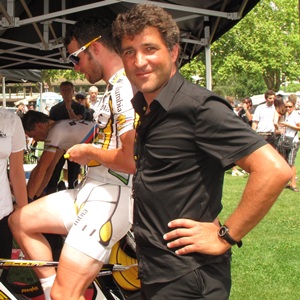
We had the opportunity to sit down with Uli Schoberer, the entrepreneur and engineer who created SRM – and started the power craze. He tells us about how they started, where they’re going, and some very interesting pieces of history. Uli now splits his time between their three offices in Germany, Italy, and the United States. He is a busy man, but has an undeniable passion for his business and bicycles.
Slowtwitch: First off, Uli, thank you for taking the time.
Uli Schoberer: It is no problem.
ST: How did SRM get started?
Uli: I am an engineer, but I was an athlete too. And I was a perfectionist. I wanted to train better than the others, and I figured out really early that for good training you need power. Because power is what you want to increase in training. If you don’t have the power you can’t really qualify the quantity of the training, the quality of the training, and the intensity. I was thinking, “How can I measure power on the bike?” I started first on the cranks, but then there was the problem that you have to connect both cranks. And at that time there was no wireless system available; this was maybe, 1986 or ‘87. So then I had to get at the first part of the bike where all the torque as added; this is the piece between the axle and the chainring [crank spider].
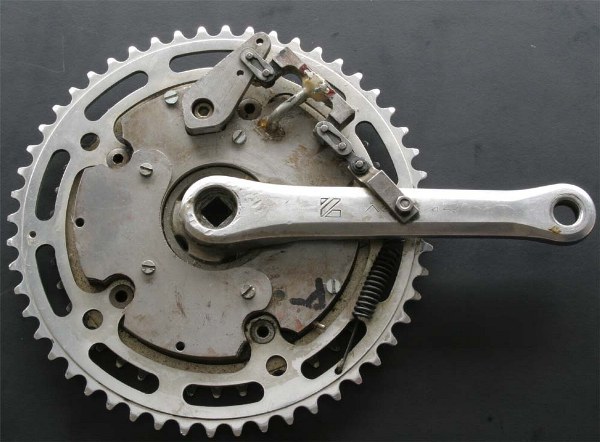
Then next question was how to transmit the data from the [crankset] to the frame. I had the idea to make an inductive transmitter, the same like Polar used for years with their heart rate belt. It wasn’t wireless. And then, what sensors to use? We decided to use strain gauge strips. It’s a really reliable piece of electronics… it’s easy to use, and easy to handle.
Now, we want to measure the power… but for power, we need average torque.
So I had the idea to transform the signal from the strain gauge strips in to a frequency, and simply count the frequency per one rev. Let me explain… you have a frequency that’s proportional to a torque. And what you need is that average torque per rev. It’s easier to count a frequency, than rather to digitize this on the crank. This was 1986 or ’88… it was not possible. There wasn’t a microprocessor that could sit on the crank and do this. So you have to transmit something that is easy to handle. So this is why each power meter has a slope of, say, 30 hertz per newton meter. A zero offset, a certain frequency. If you look at the competitors, they copied the idea and do it in a similar way. Originally we wanted to transmit the data optically, like the way you have a control unit for the TV. But it does not work with too much dirt, and you see how dirty a bike can get.
We also made a [power measuring] pedal very early, but it was not as good. It’s an exposed piece, and a pedal doesn’t last as long as a crank. And it’s easy to hit the ground, or you’re on a mountain bike and hit a rock. And there are so many types of pedals and cleats. It’s easier to change a crank than the pedal system. If an athlete is used to a Speedplay pedal, and he has to use a Time pedal, or a LOOK pedal, or a Shimano pedal…. It’s too difficult. A crank is still a crank, and it doesn’t interact that close to the human body like a pedal.
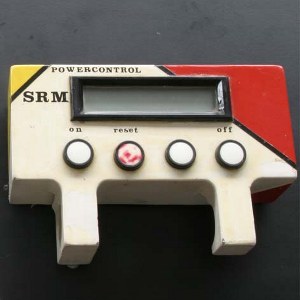
ST: Tell us about your Engineering background.
Uli: I’m a Medical Technical engineer. This [power measuring system] was the thesis at the end of my study. I had not that much time to race bikes. I had the first computer on the bike; the big PowerControl was like a Game Boy. Sometimes it fell off the bike… so I’d stop in the race to pick it up, and they were all laughing at me. They say, “oh this is the guy with his Game Boy….”
ST: What was the inspiration behind your design?
Uli: If you look at the first power meter, it works different than today. The spider was sitting on a ball bearing. The crank was fixed with a bending element to the chainring. Not like now, you have a spider with the strain gauge strips, and this is screwed on or bolted on to the cranks. It’s a better way because it’s one piece and much lighter.
It should be reliable; it should work. Simply it should work. You shouldn’t think about “Oh I have to recharge my power meter every 8 hours, or whatever. It should run 100 or 150 hours. The power meter should run 2,000 hours, so you can train the whole year and not need to think about ‘I need to replace maybe a battery, or….’ No, it should run reliable and long. This is what I want. Before we had a battery that you could replace, but it was not reliable, it was too exposed. The battery now lasts usually for two or three years for most [people].
Competitors, there’s not really one that makes the whole system. If you look at Quarq, or Power2Max, or… Look makes a pedal, and Polar makes the computer…. We wanted to make [a complete system]. We make the torque sensor, we make the computer, and we make the software.
Also, in the past we taught the coaches. So I worked from 1988 to the Olympic Games in Atlanta for the German Federation. I collected all the data. And the first pros who used the system were the pros coached by a professor that was also the UCI doctor who did all of their research. And in the US I worked with [Chris] Carmichael for the Olympic games in Atlanta. More on the mountain bike, but also in the team pursuit. Like on the GT Superbike. And on the pro side was Greg LeMond, he used SRM. He was the first one. Also, the East German national team, and the British Federation. So we have a lot of input from high class athletes since when we started; for 20 years. If you look at the pro peloton, more than half of the pro riders have our product. We get the data, and the customers want to see it. For example, the winner this year of Milan San Remo [Simon Gerrans]. They see it works reliable. And the pros wouldn’t put it on the bike if it didn’t work.
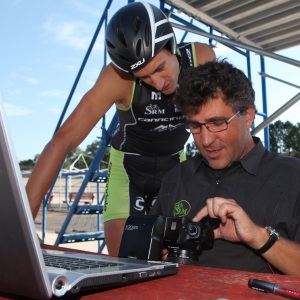
ST: What role does athlete sponsorship play for SRM?
Uli: SRM has a close relationship with many top triathletes over the world. We sponsor the SRMlive Telemetry team athletes: Cameron Brown, Dirk Bockel, Maik Twelsiek, TJ Tollakson, Catriona Morrison, Caitlin Snow, Kelly Williamson, Amanda Stevens, Rachel Joyce, and Joanna Lawn, Faris Al Sultan – I did an aero test with him and then he won the Ironman in Hawaii. Michael Weiss, our on-site triathlete, also receives full support from SRM and helps with product testing and feedback. Also, we sponsor the Raelert brothers, the Bennetts, Luke Bell, Matt Chrabot, Angela Naeth, and Branden Rakita. We used to work with many triathletes who are now retired, Wolfgang Dittrich, Normann Stadler. Normann Stadler was a friend; he came to my birthday parties.
ST: And who do you sponsor in road cycling?
Uli: We work close with Basso, Cancellara. The Schlecks are more driven from the outside; what they should do. Like when Michi [Weiss] did the aero test – he was interested, but not his coach. The energy needs to come from the athlete.
It is driven by history. Normally we sponsored no one. They had to pay. The first systems T-Mobile had, they purchased. Then it changed from T-Mobile to High Road. Since then, only the systems got replaced to newer ones. Now we sponsor teams like Lampre, Movistar, Radioshack, BMC, Team Sky, and Liquigas Cannondale.
ST: Lance Armstrong continues to rely on SRM for his power needs. Are you involved in his training for Ironman Hawaii this year?
Uli: Today, yes.
ST: What do you think his chances are for success?
Uli: I don’t know. I don’t know how aero he is sitting on the bike. We wish him the best. You know, why not? If he is the strongest, he should win.
ST: What is your take on the new trend towards shorter crank lengths for triathlon and time trial?
Uli: We tested this a lot in cycling with several teams. We could not find any increase of power with shorter or longer cranks…. It doesn’t matter. It matters only if it goes over a certain length or under a certain length. But if someone asks should I use 172 or 170… I say use what you feel comfortable with. In general – in general – with a shorter crank you can spin faster. And you have more leg room, so you can make the bars lower. But some athletes, like Bjarne Riis, he had really long, skinny legs – he felt more comfortable with a longer crank because he didn’t have the force to push a shorter crank, to create the same power. But in tests, there was no difference. But in general with a shorter crank you choose a higher cadence, and a longer crank you go to a lower cadence. But the power to heart rate relationship is the same.
ST: How short will they go?
Uli: On the track they use 165 for many years. We did tests down to 150; this is why our ergometers have adjustable [length] cranks. We did hundreds of tests, maybe 10 years ago, but no difference from crank length. Our last test with T-Mobile we did tests on L’Alp d’Huez, and some cyclists rode it 6 times. With different crank lengths, ovalized chainrings, round chainrings… we measured lactate, heart rate, power… We found that only what counts is power to body mass.
For triathlon it’s different because you do not ride at the limit, and you have to run 40 km after. Don’t ask me. I don’t know. It is hard to measure a benefit in running [from moving to a shorter crank]. If I give someone a shorter crank, and he runs the marathon the same time as he did with the longer crank…. And maybe he does the bike ride in the same time as with the longer crank. Shorter people, in relation to the length of their body have long cranks, and tall people have short cranks compared to their body.
I think under 150 millimeters gets too short. Bike crank lengths developed over 100 years, and there’s a reason why it’s around 170. You can put a 200 millimeter crank on your bike, but you will feel uncomfortable; it is too long. And if I put a 150mm on, you feel limited. You feel limited in the motion of your legs. Same as with rowing. You want to have a longer pull. Not too long, but you feel more comfortable if you use the full length of the muscles. Like a boxer, he makes a full punch; you can use more muscle. Not too much, not over stretched, so there is an optimum range. I think it doesn’t really matter. It’s force over time. I think it takes away the concentration of your training if you think too much about these things. You should focus more on the quality of training.
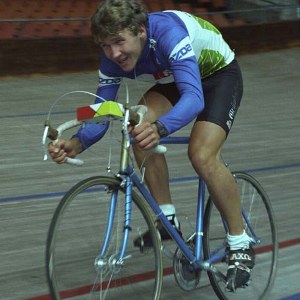
ST: Training with a power meter has evolved significantly over the past 20 years. Where do you see it going in the future – what further developments will there be?
Uli: Power is power. Power is a value. It will not go anywhere, where should it go? What I figured out is it’s very individual. You need a good coach who can read the data in a correct way. If you only look at the relationship of power to heart rate, and you think that the higher the power and the lower the heart rate, it is good. No, it means nothing. You have to look at different things like reaction time of heart rate when you change power. Is if fast, is it slow? When you get tired, your reaction gets slower and slower. If you have a very good power to heart rate relation, and you say “good”, but the high end may be cut off. And you only get the high end when you are rested. But sometimes you have to train several days in row and get really tired, but you can’t do this too much. The future is with coaching and training methods. You have a lot of names like training score and whatever…. But you need a good coach.
ST: One thing that many people aren’t aware of is SRM’s involvement with the space program, and the physical testing of astronauts and cosmonauts. Please tell us about that.
Uli: Yes, in the space station MIR. I think it was in 1988 or 1989. I was invited; there was a professor who was responsible for the fitness of the Russian cosmonauts. He needed a device that could go in the space station that could measure the power. His target was to see how on a daily basis, the power decreases as they get weaker.
ST: Did any SRM units actually go up in to space?
Uli: They had two – one on the ground, and one in the space station. His idea was that we should start cycling in space. So he wanted a round space station, where you can cycle inside, maybe at a diameter of 40 meters. So 2, 4, 8 [people] can cycle. And as soon as you are cycling, you create your own gravity. When you create your own gravity, you train all muscles of your body, because then you have a weight. In the space station you need no muscles, like for your neck. When they come out, they sit in a wheel chair. You cannot even hold your head. But when you cycle and create gravity, you train all muscles, for your intestines and everything. But it never came together; they had no money. I think in 500 years, if there are space stations, maybe people will cycle there.
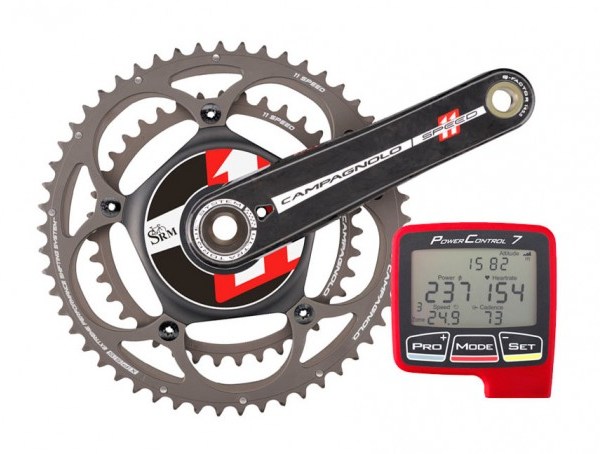
ST: In looking at cycling vs. triathlon, are there any trends with sales? Do you market differently for the two groups?
Uli: They say maybe triathletes have more money, but I don’t know. For example, in Italy, the average pro cyclist is a poor guy. They want second hand SRMs; it can be 10 years old and they don’t care; they just want the power.
In the end, we want to sell power to athletes… cyclists and triathletes. We want to make a power meter, for all kind of athletes, and for as many possible brands…. From FSA to Campagnolo, to Shimano. So that everybody can find what he wants. And also we want to have a link to other software providers, like Training Peaks, or others that can read our data. And also if they want to use a Garmin device, they can pair with a power meter and read our data. Our system is open.
ST: Anything else you would like to add?
Uli: I think make the product that reflects your philosophy. That the product is what I want it to be, and what I think the customers want. When I started there was no power meter. Maybe for 15 year my work was to convince people why they need power. We had to open the market for a power meter. It was not easy, but now we have some success.


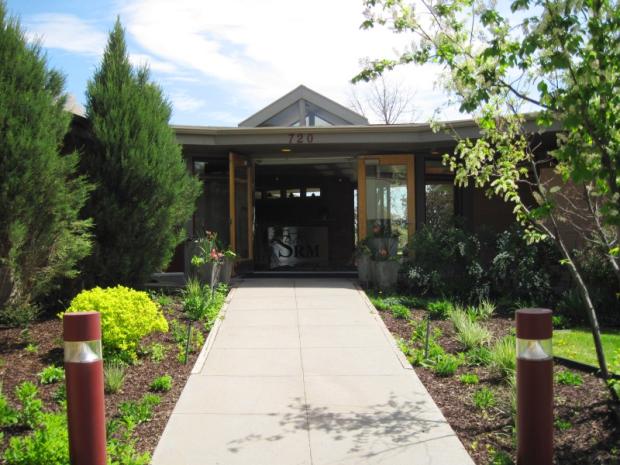
Start the discussion at slowtwitch.northend.network